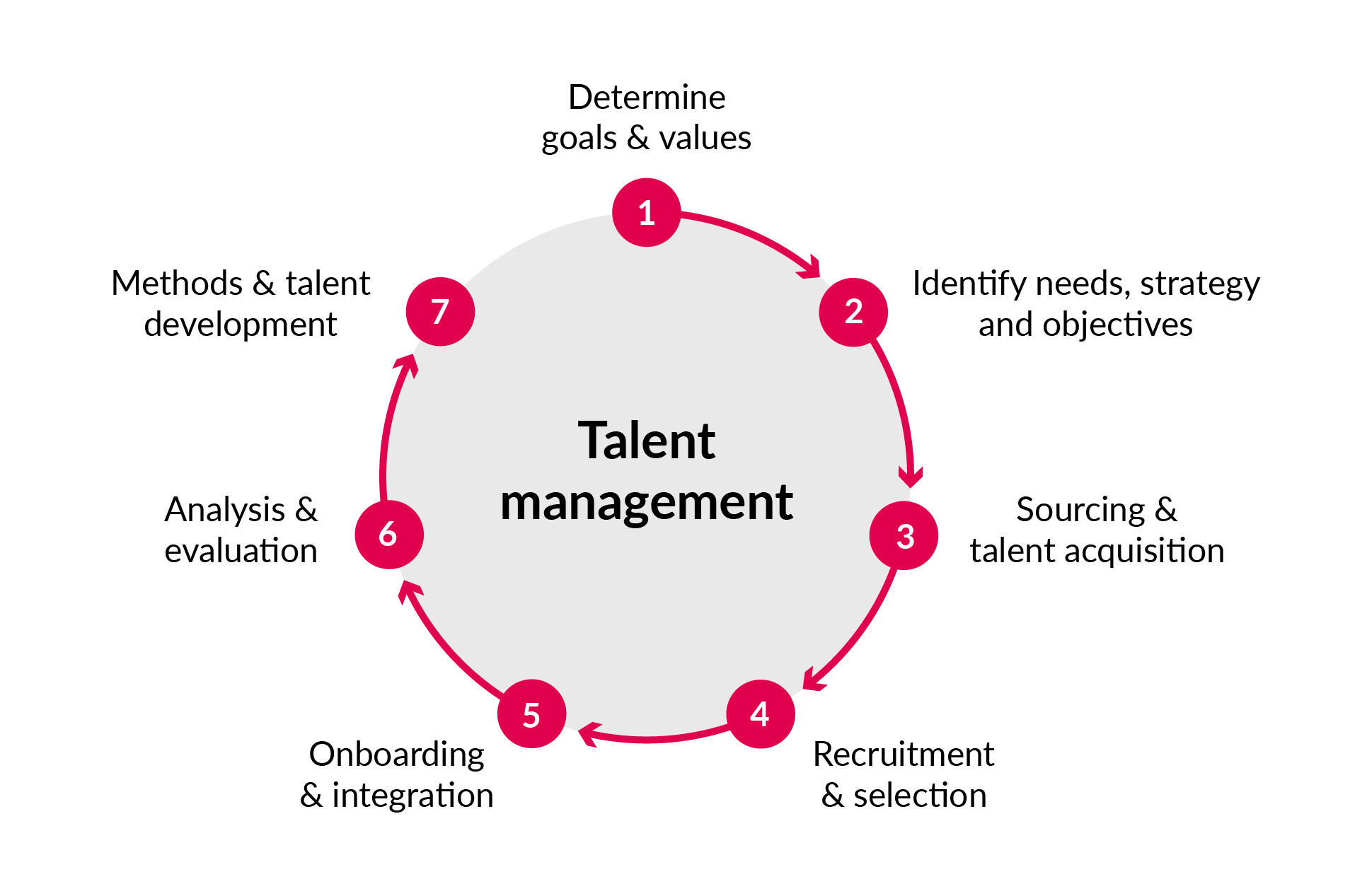The art of talent management: How to find and retain the best employees

In today’s corporate landscape, talent management has proven to be the key factor for ensuring long-term business success. The term refers to the strategies, practices and processes that an organisation implements in order to find, retain and upskill qualified employees. It’s part of creating a positive working culture as well as boosting individual employees’ commitment and performance. In this article, we define the most important aspects of talent management – showing what companies can do to not only recruit the best staff but also to motivate them and retain them on a long-term basis.
Talent management: not just a buzzword
Talent management is an increasingly popular concept, but is there an actual strategy behind it? In fact, widely discussed in the field of business studies, according to Lawler (2017) talent management should be a rigorous, evidence-based practice that ensures the best people for the best role are supported and rewarded to ensure the organisation’s continued success. Talent management goes beyond the general responsibilities of human resources management. It specifically focuses on attracting and retaining rare target groups of potential employees whose skills give them unique importance for the company’s success.
What does ‘talent’ mean?
In the context of talent management, talent means the skill, aptitude and potential of employees who can make a significant contribution to the company’s success. These skills can be either inherent or acquired. Talent management is the art of facilitating employees’ development, motivation and commitment.

The term “skilled workers” refers to employees who hold skills that enable them to successfully perform certain tasks or fill a particular position. “Unskilled workers” describes those employees who do not have the same previous experience or qualifications. Talent management describes the recruitment and ongoing management of “skilled workers”, or the transformation of “unskilled workers” into this category during their time at the organisation.
How talent management influences the company’s success
Talent management is a major part of building a positive company culture. Choosing employees wisely and empowering them to play to their strengths can create a work environment that encourages cooperation and the exchange of ideas. When your employees feel recognised for their skills and contributions, staff turnover will be reduced, and the team will have a stronger sense of commitment to your company. An environment like this will boost creativity and promote a culture where employees can challenge established processes with new ideas. As you can see, companies with an effective approach towards talent management gain many advantages – the next section will go into more detail on how to succeed in this area.
Talent management strategy
Talent management strategy refers to an in-depth plan on how to win the best talent for your company, and then how to further those individuals’ professional development, for the organisation’s benefit as well as their own. This strategy lays out a path from defining your goals to carrying them out and shows how you can embed talent management within your company’s vision and values.
Defining goals and values
In order to build an environment in which employees can perform at their best, the company’s values should be a key part of the hiring process, and the company’s goals should be something all employees are working towards together. Then, the company’s goals and values can become guidelines for individuals as well as departments. For example, imagine an innovative tech company who specialise in sustainable energy. Their values are social accountability, caring for the environment and technological progress. Their employees should also hold these values, and while this starts during the hiring process, it is important for current as well as new staff. A company should reinforce their values and goals through their actions as well as through internal communication.

The talent management process
Talent management processes should take the form of a well-organised sequence of steps, to help companies implement their strategy. From the initial hiring process into ongoing talent management, we will explain each step in the following section.
Planning: identifying needs, strategic plans, and goals
The first step is to plan ahead, carefully analysing which specific qualifications and skills will be needed to fill future positions. For example, a healthcare organisation’s analysis could show that it requires further expertise and a higher number of nursing staff in order to develop further. Determine who the company needs to hire in order to meet their goals – where do you notice a skill gap that new hires could fill?
Sourcing & talent acquisition: finding and securing the best talent
After identifying which skills and competencies you are looking for, the time has come to source talent. Use job boards to advertise the opening, and candidates will directly apply to you. You can also attend job fairs to network with possible candidates. But there are more focused methods by which you can approach them. Employment agencies can act as an intermediary between you and the candidates by pre-selecting the most suitable applicants. You can use LinkedIn to search for professionals with the required qualifications and skills. Any of these methods will help you build a talent pool from which you can identify potential candidates in the future.

Recruiting & selecting: the highway to a strong company
The next step is recruitment, narrowing down from the potential candidates you sourced to the one you want to hire. The focus is on identifying the candidate with the right skills and qualifications who will be a good fit for your organisation. The process should not be too long or short. Recruiting too quickly comes with the risk of selecting staff who are not perfectly suitable – go too slowly, and you could deter potential candidates who might decide to accept another position while you decide. There needs to be a balance between an in-depth selection process and an efficient interview stage, keeping up the pace of the recruitment process while also making sure that you get to know the potential candidates before you hire.
Onboarding & integration: the key to successful onboarding
To enable any new staff member to integrate into the team quickly, a company should organise an appropriate implementation plan consisting of in-company training, introductions to the rest of the team, and initial hands-on tasks. The induction phase, which begins when the new employee signs the contract and ends when they complete their probationary period, is incredibly important. During onboarding, the new employee should be introduced to the tasks and established processes their role involves in a structured way. Their colleagues should present the company culture and start building a good working relationship together.

Performance rating: analysis & evaluation
The next step of talent management in the life cycle of a new employee is performance rating. Once they are on-boarded and well-integrated, the company should undertake the first performance rating. Often carried out by the member of staff’s line manager or hiring manager, this review identifies strengths as well as areas for further development. A performance rating is an opportunity to show employees that their work is recognised and appreciated. KPIs or Key Performance Indicators are used to measure performance against targets such as sales figures, demonstrating which goals the employee has achieved and what needs to happen next.
Talent development methods: effective basic approaches
Like performance reviews, professional development is a step that will continue throughout an employee’s time at their organisation. Training courses, mentoring within the company or other forms of professional development should be accessible and encouraged. Employees’ skills within their fields can be enhanced, and they can explore their individual development as a professional in their industry. Building mentor relationships within your company is a powerful tactic to ensure knowledge and processes are shared with new staff, and to help build strong working relationships. You might even find that someone who started in one area of the business has the potential to successfully transfer into another.

Challenges in talent management
While there are clear steps that companies can follow to help streamline their talent management strategy and processes, there are also challenges. Companies in certain sectors or regions might suffer from shortages of skilled workers who have the attributes they need. Ongoing talent management is also resource-heavy and takes time, which presents issues for busy companies who are limited in one or both of these aspects. From planning a talent management strategy for a single employee to assessing your corporate culture from the top-down, talent management involves a wide variety of different tasks and responsibilities. This topic will affect every area of the business, so everyone must be in alignment – while much of talent management sits with HR, you can see that departmental and senior management also have a large part to play.
The future of talent management
The talent at your company is its most valuable asset. Talent management will help your business stay agile in response to changing market conditions, new best practices in operations, and technological progress. The more your employees can learn from each other, make important new hires, and support each other to develop, the more your company will benefit.
Explore our offer and let us help develop your talent management strategy. Find out more on our main website.
Find out more